Let's get some definitions and rules! We're going to sift through 19th century game books here to trace the language around bagatelle and related games.
It's important to note that some of the dates for these books need to be eyed with skepticism as they might not be accurate to the edition.
1801 / 1810 / 1903 The Sports and Pastimes of the People of England from the Earliest Period: Including the Rural and Domestic Recreations, May Games, Mummeries, Pageants, Processions and Pompous Spectacles by Joseph Strutt
 |
this was first published in 1801, but this edition is from 1903 and has had SUBSTANTIAL editing. If you know where to locate a proper FIRST edition, please do let me know.
|
 |
| excerpt from the 1903 edition, but this also is included in the 1810 edition |
I am unsure if Troul In Madame is a corruption of Trou Madam or a variant name given specifically due to the play being done with cues/maces, and so a new name needed.
It says it is "not unlike our modern bagatelle, only played without a cue or mace", but while it's exciting that bagatelle is called "modern", note this from the preface:
 |
| this passage does not exist in the 1810 version, so we can't use that to date 'bagatelle' |
I had forgotten about The Benefit of the Ancient Bathes of Buckstones, but yes that 1572 work did reference Troule in Madame.
Oh hey look it's that 1572 quote:
A friend offered this modern take on the above text,
The Ladies, Gentle Women, Wives and Maids may in one of the Galleries walk: and if the weather be not agreeable to their expectation, they may have in the end of the Bench eleven holes made, into which to "trowle pummetes" or Bowls of lead, big, little or mean [average], or also of Copper, Tin, Wood, either violent or soft, after their own discretion, the pastime Troule in Madame is termed.
Likewise, men feeble, the same may also practice in another Gallery of the new buildings, and this does not only strengthen the stomach and the upper parts above the midriff or waist: but also the middle parts beneath the sharp "Gristle" and the extreme parts, the the hands and legs, according to the weight of the thing "trouled", fast, soft or mean.
This next text might be the earliest description of what we refer to as "pin bagatelle". All of the critical components are described: curved top, elevated, a channel to drive the ball up, and it falls down "interrupted in its descent by wires inserted at different distances upon the table, which alter its direction and often throw it entirely out of the proper track." The 'wires' spoken of here probably refers to gates and/or pins. It also describes the gates used in games like Mississippi for receiving the balls at the bottom. While we know Trou Madam can be traced to the 16th century, I am unsure as to the origins of the name 'Mississippi'.
This would lend obvious weight to the idea that pin bagatelle arrived by tilting a trou madam / mississippi table so that balls fell down towards the numbered gates to score.
From what appears to be the original 1801 edition, a scan done by Google Books:
(the characters that look like a long "f" are actually pronounced as "s".)
2 other
Rocks of Scilly references passed to me, which don't offer any real extra details but do give proof of existence.
 |
| 1804-04-05 The Morning Chronicle (London) |
 |
| 1811-05-06 The Leeds Intelligencer and Yorkshire General Advertiser |
Here is the entry on Mississippi
from the 1810 edition, where it describes it as a billiard-like game where the balls are 'cast' (rolled) towards a set of arches for points.
I had previously thought Mississippi to be exclusively a cue/mace game, but I suppose it started out with just rolling the balls? It's hard to tell for sure with just this description to go on.
The only real difference I can tell between Trou Madam and Mississippi is that Trou Madam lets you shoot straight into the scoring holes, while in Mississippi you have to bounce of the side bumper.
(James tells me in a chat, "Earlier tables were not smooth, uniform or level so knocking it straight into a hole was more of a challenge. As table technology improved and maces changed to cues so accuracy also improved, it became too easy. So then they added the rule that you had to bounce it off a cushion to make it suitably challenging.")
1847: Castles In The Air vol III by Catherine Grace Francis Gore
This is the earliest mention of the game cockamaroo that we've found so far.
 |
| p 246 of Castles In The Air vol III |
1854: The Handbook of Games...
Bagatelle games are played on a standard 9-hole bagatelle, or sometimes known as an English Bagatelle table. It mentions a "Mr. Thurston, Catherine Street, Strang" as a seller, costing 13-15 guineas each.
"La Bagatelle" as it's called here, is the traditional method of playing on a 9-hole bagatelle board. A player has 9 balls, one of which is black and is placed at the proper point on the board.
Sans Egal is a bagatelle variant where 2 players take turns, using 4 balls different in colour than the other player.
Mississippi is played on a 9-hole bagatelle board, but utilize the "bridge" (a wooden fixture with many tunnels/gates for balls to go under). Balls must strike the cushion before entering the holes.
Trou Madame a far older variant (played on tables in the 17th century well before side cushions were invented,) is easily played on the bagatelle table. The cushions do not even matter because all you do is shoot balls from one end and into the holes on the bridge.
Now we get into some pin bagatelle:
 |
| 1854 Hand-Book of Games, edited by Henry G. Bohn |
Russian Bagatelle or Cockamaroo are given rules here! So many things to take note of:
- There is what we call a "king ball" placed at the top, and once dislodged that hole then awards100 points, the amount needed to win.
- Left and right channels
- slots along the bottom to award points
- Ringing the bell is said to double your points, but only if the ball continues down the playfield and doesn't settle into the cup with the bell
1860: The Handy Book of Games for Gentlemen by Captain Crawley
On to 1860!
The nomenclature of "The French Game" is introduced here, another slight variant on a 9-hole bagatelle board.
 |
| 1860 The Handy Book of Games for Gentlemen by Captain Crawley |
The Canon Game - played with three balls, and I think it's an older spelling of 'carom', as in, ricochet.
The Irish Game - a variant of the canon game
It also makes note that "I have lately seen some bagatelle boards [...] with two pockets, in addition to the nine holes". These are regular billiard pockets on opposite sides, halfway up the bagatelle board.
I love the shade cast at pin bagatelle in this paragraph:
I then went through the 1865 Beeton's Handy Book of Games by Captain Crawley, but it appears to be a re-branding of the 1860 book by Crawley with no new information.
 |
| 1865 Beeton's Handy Book of Games by Captain Crawley |
I then checked the 1867 edition of The Hand Book of Games by
Henry G. Bohn and it is identical to the 1854 edition.
1868: Billiards for Beginners by Captain Crawley
Crawley returns, taking his 1860 work and actually applying an editor's eye to them. The rules are far more concisely laid out, and it less like a screed against lower forms of cue sports.
1868: The Modern Pocket Hoyle by "Trumps"
This is a rework of the 1854 "Hand-Book of Games", now under the Hoyle brand.
 |
| 1868: The Modern Pocket Hoyle by "Trumps" |
There is one exciting difference right off the bat: the 1868 edition adds the diagram for the far more obscure 15-hole bagatelle table!
 |
| "In the larger table, which is from twelve to fourteen feet long, the cups are fifteen in number." |
I am happy to discover a reference to 15-hole bagatelle. I have never seen it referenced before, but that is the kind of table that appears in the famous 1864 political cartoon featuring Lincoln
 |
| this table actually has 20 holes, but still you almost never see an English Bagatelle table with more than 9 holes. |
1870: How to Play Chess Billiards Bagatelle Whist Loo Cribbage Draughts Backgammon Dominoes and Minor Games at Cards
This book is mostly a rehash, and covers only games played on 9-hole bagatelle boards.
An interesting note is how the labels are evolving:
La Bagatelle now shares the title English Bagatelle.
"Bagatelle a la Francais" is now also called just French Bagatelle.
The cannon Game is also called "Bagatelle versus billiards".
1870: Harper's Weekly advertising
I am including this incredible advertisement tucked in between pages entirely unrelated to the topic at hand. These "Lozo-Pendulum Board" games are pretty cool, and it's an example of the word 'bagatelle' being applied to a kid's toy before the Redgrave patent.
1872: Hoyle's Games by Thomas Frere
Nothing new to see here.
1885: The Boy's Own Book
This book discusses a few games with bagatelle in their name, but without much real connection to actual bagatelle. I find it is important to include these so we can check against other period references to have a better idea of what they might be discussing when they say 'bagatelle'.
Also including this note on Parlour Croquet since it would easily get lumped in with all of the table games:
The book has a later section on proper bagatelle, but there's nothing novel there, but some excellent illustration including a 15-hole bagatelle!
1890: The Young Folk's Cyclopædia of Games
This entry is delightful because it covers the basics, has the diagrams, but also gets us into Tivoli!
This description of Tivoli shows the influence of Parlor Bagatelle, as it discusses a single channel for shooting, and then says the mirrored channel is sometimes found on this game.
It also gives us the term Railroad Bagatelle, which seems to describe what I know as Bowling Naco: a table game where the ball is rolled down a ramp or spiral towards pins or scoring holes, but the angle it is deflected can be altered by the player.
an example of bowling naco:
 |
Bowling Naco
Brevete
L. Nachez
Wemmel-Bruxelles |






















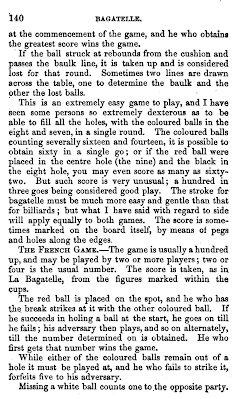
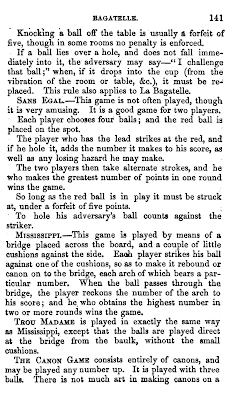






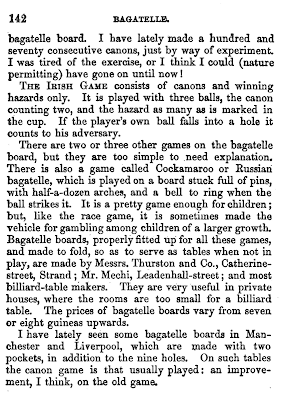







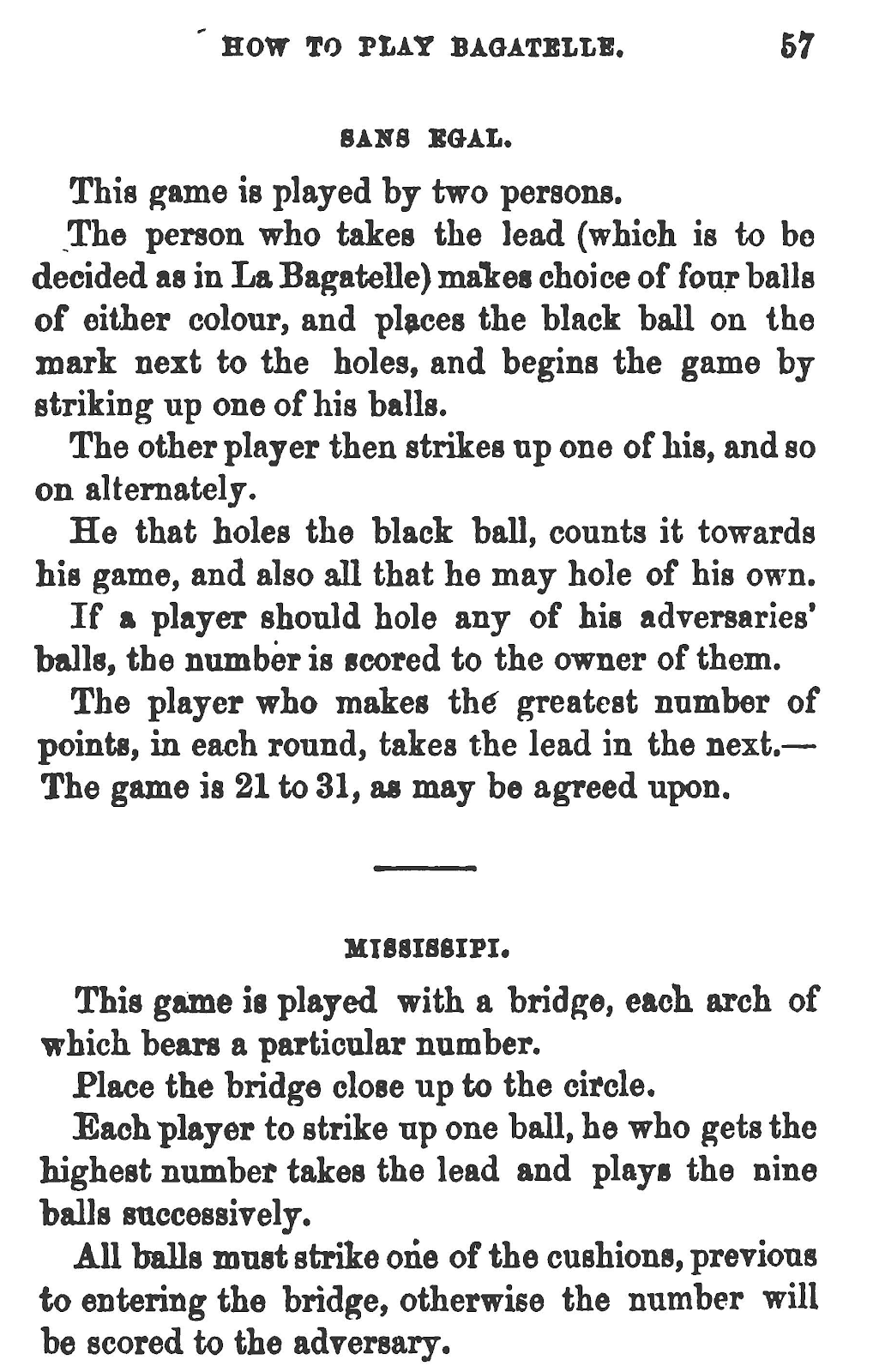

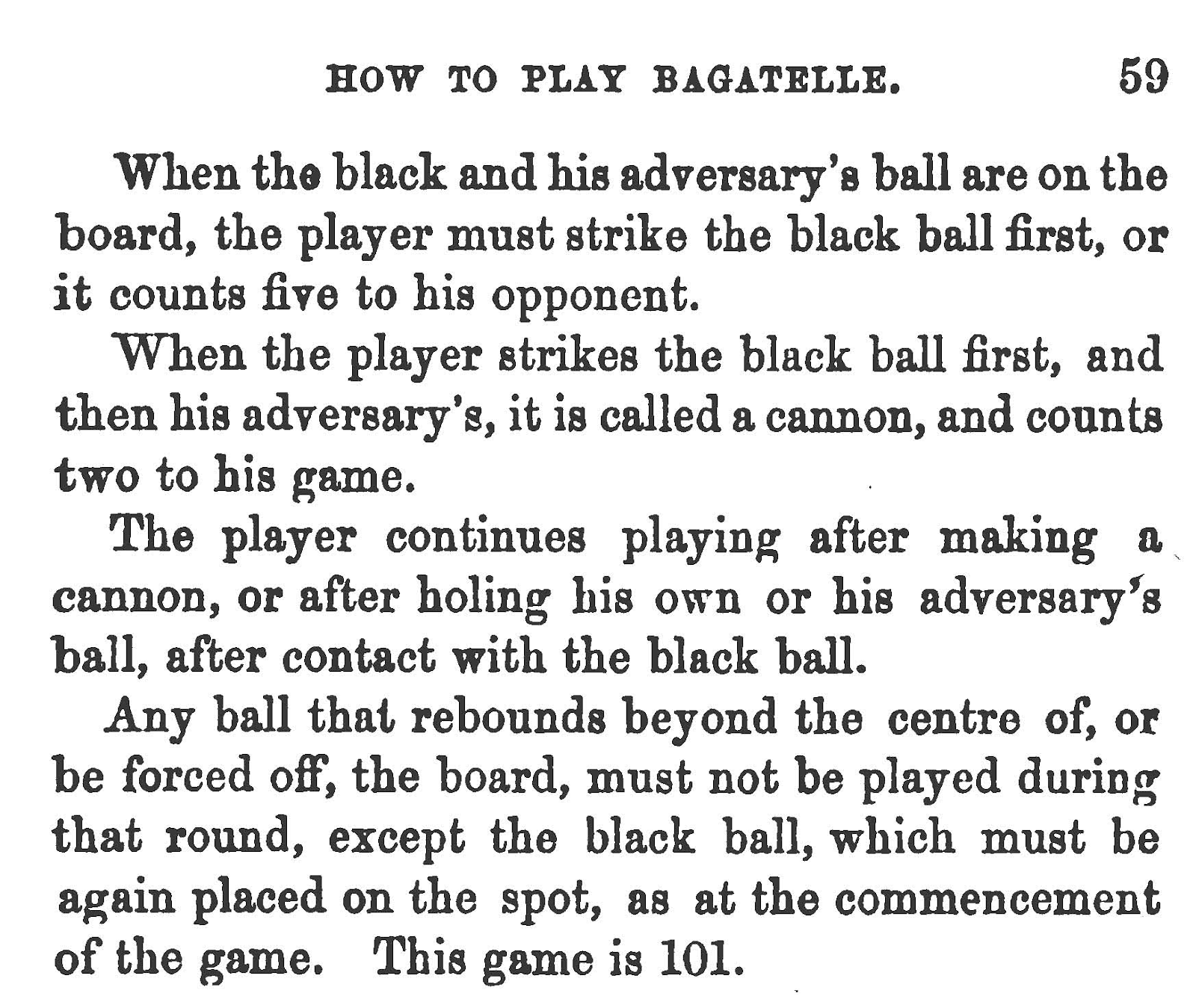

















No comments:
Post a Comment